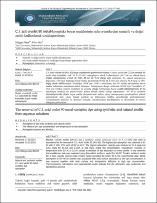| dc.contributor.author | Okur, Müjgan | |
| dc.contributor.author | Aktı, Filiz | |
| dc.date.accessioned | 2019-07-16T10:43:10Z | |
| dc.date.available | 2019-07-16T10:43:10Z | |
| dc.date.issued | 2016 | en_US |
| dc.identifier.citation | Okur, M., Aktı, F. (2016). C.I. asit viyolet 90 metal-kompleks boyar maddesinin sulu ortamlardan sentetik ve doğal zeolit kullanılarak uzaklaştırılması. Gazi Üniversitesi Mühendislik Mimarlık Fakültesi Dergisi, 31(3), 677-686. | en_US |
| dc.identifier.issn | 1300-1884 | |
| dc.identifier.uri | https://doi.org/10.17341/gummfd.86378 | |
| dc.identifier.uri | https://hdl.handle.net/11491/3636 | |
| dc.description | research | en_US |
| dc.description.abstract | C.I. Asit Viyolet 90 (AV 90) boyar maddesinin gideriminde Manisa- Gördes zeoliti (M-GZ) ve sentetik bir zeolit olan moleküler elek 10 Å (Z-10A) adsorplayıcı olarak kullanılmıştır. pH 2'de en yüksek boyar madde adsorpsiyonu Z-10A ile %93, M-GZ ile %73 olarak elde edilmiştir. En yüksek adsorpsiyon kapasitesi, 150 mg/L başlangıç boyar madde derişiminde M-GZ ve Z-10A için sırasıyla 51,4 mg/g ve 1461 mg/g olarak belirlenmiştir. Sıcaklığın 303K'den 333K'e arttırılması, her iki zeolite adsorplanan boyar madde miktarının azalmasına neden olmuştur. Adsorpsiyon denge verilerinin M-GZ için Freundlich, Z10A için Temkin izoterm modelleri ile uyumlu olduğu belirlenmiş, boyar madde adsorpsiyonunu en iyi tanımlayan modelin ise pseudo-ikinci derece kinetik model olduğu saptanmıştır. AV 90'ın zeolitlere adsorpsiyonunda, düşük boyar madde derişimlerinde sadece yüzey adsorpsiyonu gerçekleşirken yüksek derişimlerde hem yüzey hemde partikül içi difüzyonun birlikte gerçekleştiği gözlemlenmiştir. Termodinamik analizler ve deneysel sonuçlar, adsorpsiyonun kendiliğinden ve ekzotermik bir proses olduğunu göstermiştir | en_US |
| dc.description.abstract | Manisa- Gördes zeolite (M-GZ) and a synthetic zeolite molecular sieve 10 Å (Z-10A) was used as adsorbents for the removal of C.I. Acid Violet 90 (AV 90). The highest dye adsorption was obtained as 93 % with Z-10A, 73% with M-GZ at pH 2. The highest adsorption capacity was obtained as 51.4 mg/g and 1461 mg/g for M-GZ and Z-10A at 150 mg/L initial dye concentration, respectively. Increase of temperature from 303 K to 333 K caused to decrease of dye adsorption on every zeolite. It was observed that equilibrium data was evaluated using Freundlich isotherm model for M-GZ, Temkin isotherm model for Z-10A, pseudo second order kinetic model provided the better fit to the experimental data. While adsorption of AV 90 on zeolites was actualized with only surface adsorption at low dye concentration, it was occured together with both surface and intraparticle diffusion at high dye concentration. Thermodynamic calculations and experimental results indicate that the adsorption was exothermic and spontaneous process. | en_US |
| dc.language.iso | tur | en_US |
| dc.publisher | Gazi Üniversitesi | en_US |
| dc.relation.isversionof | 10.17341/gummfd.86378 | en_US |
| dc.rights | info:eu-repo/semantics/openAccess | en_US |
| dc.subject | Doğal ve Sentetik Zeolit | en_US |
| dc.subject | C.I. Asit Violet 90 Metalkompleks Boyar Madde | en_US |
| dc.subject | Adsorpsiyon | en_US |
| dc.subject | Natural and Synthetic Zeolite | en_US |
| dc.subject | C.I. Acid Violet 90 Metal - Complex Dye | en_US |
| dc.subject | Adsorption | en_US |
| dc.title | C.I. asit viyolet 90 metal-kompleks boyar maddesinin sulu ortamlardan sentetik ve doğal zeolit kullanılarak uzaklaştırılması | en_US |
| dc.title.alternative | The removal of C.I. acid vıolet 90 metal-complex dye using syntheticand natural zeolite from aqueous solutions | en_US |
| dc.type | article | en_US |
| dc.relation.journal | Gazi Üniversitesi Mühendislik Mimarlık Fakültesi Dergisi | en_US |
| dc.department | Hitit Üniversitesi, Mühendislik Fakültesi, Kimya Mühendisliği Bölümü | en_US |
| dc.identifier.volume | 31 | en_US |
| dc.identifier.issue | 3 | en_US |
| dc.identifier.startpage | 677 | en_US |
| dc.identifier.endpage | 686 | en_US |
| dc.relation.publicationcategory | Makale - Ulusal Hakemli Dergi - Kurum Öğretim Elemanı | en_US |


















